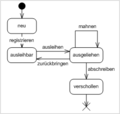Unified Modeling Language

Unified Modeling Language (UML) is a standardized visual specification language for object modeling in the field of software engineering.
Overview
[edit]Unified Modeling Language is a general-purpose modeling language that includes a graphical notation used to create an abstract model of a system, referred to as a UML model. It consists of:
- Structure diagrams: emphasize what things must be in the system being modeled
- Behavior diagrams: emphasize what must happen in the system being modeled
- Interaction diagrams: a subset of behavior diagrams, emphasize the flow of control and data among the things in the system being modeled.

Unified Modeling Language is officially defined at the w:Object Management Group (OMG) by the w:UML metamodel, a w:Meta-Object Facility metamodel (MOF). Like other Meta-Object Facility-based specifications, Unified Modeling Language has allowed software developers to concentrate more on design and architecture.
- Collage of types of diagrams
- Separate types of diagrams
-
A class diagram
-
A component diagram
-
A composite structure diagram
-
A deployment diagram
-
An object diagram
-
An activity diagram
-
A state diagram
-
A use case diagram
-
A communication diagram
-
An interaction overview diagram
-
A sequence diagram
History
[edit]-
Diagram by Guido Zockoll, 2004
-
Diagram by Michael Zapf, 2006
-
Diagram by Axel Scheithauer, 2008
-
Update by Marcel Douwe Dekker, 2008
-
Redraw by Chris828, 2009
-
Update by Marcel Douwe Dekker, 2012
Structure diagrams
[edit]Class diagram
[edit]A class diagram describes the structure of a system by showing the system's classes, their attributes, and the relationships between the classes. See Category:Class diagrams
Component diagram
[edit]A component diagram in the Unified Modeling Language depicts how a software system is split up into components and shows the dependencies among these components. See Category:Component diagrams
Composite structure diagram
[edit]Composite structure diagram is describes the internal structure of a class and the collaborations that this structure makes possible. See Category:Composite structure diagrams
Deployment diagram
[edit]A deployment diagram serves to model the hardware used in system implementations, the components deployed on the hardware, and the associations between those components.. See Category:Deployment diagrams
Object diagram
[edit]An object diagram shows a complete or partial view of the structure of a modeled system at a specific time. See Category:Object diagrams
Package diagram
[edit]A package diagram depicts how a system is split up into logical groupings by showing the dependencies among these groupings. See Category:Package diagrams
Behavior diagrams
[edit]Activity diagrams
[edit]An activity diagram In UML represents the business and operational step-by-step workflows of components in a system. An activity diagram shows the overall flow of control. See Category:UML Activity diagrams
State diagram
[edit]A state diagram in UML is a standardized notation to describe many systems, from computer programs to business processes. See Category:UML State diagrams
Use case diagram
[edit]A Use Case diagram in Unified Modeling Language shows the functionality provided by a system in terms of actors, their goals represented as use cases, and any dependencies between those use cases. See Category:Use Case diagrams
Interaction diagrams
[edit]Communication diagram
[edit]A Communication diagram models the interactions between objects or parts in terms of sequenced messages. They represent a combination of information taken from Class, Sequence, and Use Case Diagrams describing both the static structure and dynamic behavior of a system. See Category:UML Communication diagrams
Interaction overview diagram
[edit]An interaction overview diagram is a form of activity diagram in which the nodes represent interaction diagrams. See Category:Interaction overview diagrams
Sequence diagram
[edit]A sequence diagram is a diagram, that shows how processes operate one with another and in what order. See Category:Sequence diagrams
Timing diagram
[edit]- Timing diagram (added in UML 2.x)
Metamodelling
[edit]The Meta-Object Facility (MOF) is a standard for model-driven engineering. and an metamodel for the Unified Modeling Language.
UML Application
[edit]- Example
-
Facebook Metamodel
-
HBean architecture
-
Metamodel Linkedin
-
Skos metamodel
- Screenshots













































































